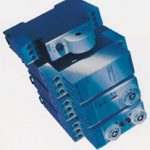The degree of automation is constantly increasing for all kinds of equipment and systems. At the same time, the requirements regarding process accuracy are being extended. Processes must be permanently available, switch off automatically in case of faults and report any reasons for maintenance automatically and in good time.
Dipl.-Ing. Josef Götz
– system that has been designed in this way requires a large number of signals that are sent to the control system and evaluated. Monitoring relays are essential for this kind of application in automation technology.
They protect equipment and systems and provide signals for the control system. Simple problems, such as a fuse tripping, a liquid level being exceeded or a belt tearing, are easily detected. In addition, an increased current consumption serves as an early indication of gradually emerging faults such as motor bearing damage.
Potential faults are therefore detected as soon as they begin to develop – and before they can cause serious damage or halt a process. Bearing damage can be repaired the next time scheduled maintenance work is carried out, for example, rather than the drive being deactivated during production by a thermal overload protection device.
This family of monitoring relays fulfills all the necessary requirements, with selectable functions and several measuring ranges per device despite only 24 different models. This saves storage costs. Most of the relays are only 22.5mm wide, which helps save space in the switchgear cabinet.
The relay family comprises the following types:
• phase failure, phase sequence,
• phase failure, phase sequence, phase asymmetry,
• three-phase voltage monitoring,
• single-phase voltage monitoring,
• single-phase current monitoring,
• level monitoring for conductive liquids,
• underspeed monitoring.
Figure 1 shows an overview of the monitoring relays. The operating elements are conveniently placed on the front. The function selectors are on the top of the device to prevent accidental switching.
Interaction with control systems
Signals can also be processed directly in coordinating controls, in which case current transformers, high-quality cables, programming work and memory are required. This is usually more expensive than installing monitoring relays.
In addition, using these relays affords the advantage of being able to set parameters directly on the front panel during operation or start-up. Setting parameters in the control system always involves programming. LEDs show switching states at a glance, which in turn makes things easier during start-up or repairs.
This is in line with the trend towards distribution, as the intelligence is situated locally and the coordinating control receives more information about the correct (or incorrect) progress of the process. An AS interface can be used here.
During the project planning phase, the planner should always consider using monitoring relays for these analog signals, as in view of the current prices on the market they are far more economical in the long run.
Phase sequence, failure and asymmetry
Monitoring the phase sequence is essential particularly for mobile machines. If the phase sequence does not correspond to that determined by the relay, it will not be energized. This auxiliary contact is used as an interlocking device against energizing, or for less critical applications as a signaling contact.
Phase failures commonly occur if a fuse is overloaded, a cable breaks or an electrical connection is interrupted. If a motor is running, it will be overloaded. By the time the thermal overload relay reacts, the motor may have suffered damage which shortens its service life.
The unbalance relay also protects the motor against overheating. If one phase decreases asymmetrically in relation to the others, the torque will be reduced to a much greater degree. If the current increases, the motor temperature will rise. This naturally puts a strain on the bearing and the insulation, which in turn leads to a shorter service life.
Two types of relay are available for solving this problem. The 3UG3511 monitoring relay is a standard model that monitors phase sequences and failures. All the necessary parameters are preset. The relay is simply connected – the user does not need to do any setting.
The 3UG3012 offers more functions. In addition to phase sequences and failures, it also monitors asymmetry. The asymmetry can be set from 5 to 20% and combined with a delay time between 0.5 and 10 s if the threshold is exceeded. The relay detects voltage regeneration from the motor up to a value of 95%.
Three-phase voltage monitoring
Voltage drops in feeder cables or instabilities in the power supply systems of certain countries or plants can lead to supply voltage fluctuations. If the voltage drops too far, some devices will malfunction, e.g. a control system may reset because of a voltage dip. Conversely, if a large load is disconnected, the voltage may exceed the setpoint and destroy the inputs of the connected devices.
The 3UG3041 three-phase and 3UG3042 three-phase + N overvoltage and undervoltage relays help prevent these faults. These devices use windowing, i.e. the upper and lower threshold values are adjustable and monitored. There is one output relay and one LED for each value. A delay time of 0.1 to 10 s can be set. These devices are normally used in enclosed units, for example switchgear cabinets.
Single-phase voltage monitoring
Single-phase overvoltage and undervoltage relays are similar to the three-phase ver-sions. One phase, to which sensitive devices are connected, is protected against voltage fluctuations.
Among the other possible applications are monitoring battery voltage, uninterruptible power supplies, power supply units, etc., or voltage used as a control signal.
This range includes three variants. In onerelay the measuring-circuit and supply voltages are separate, with a measuring range from 15 to 600 V in three steps. The other two variants have a combined measuring-circuit and supply voltage, with measuring ranges from 15 to 150 V and 50 to 275 V respectively. One relay uses windowing, while the other has an adjustable threshold and hysteresis. The overvoltage and undervoltage functions and latching/non-latching can be set by means of sliding switches on the device (depending on the variant).
Single-phase current monitoring
The current monitoring function is the most versatile in the family of monitoring relays. A technician can tell from the load characteristics of a motor when maintenance is necessary or a pump is clogged. Current monitoring is helpful here.
If the motor’s mechanical load increases, the motor current will increase to the same degree. The monitoring relay is switched when the set threshold is reached and reports to the control system that maintenance or an inspection needs to be carried out (it may also indicate this by means of a lamp, etc.).
The user can also use the monitoring relay for load shedding. If the current in one phase becomes too high, a relatively unimportant load is disconnected from the system.
Continuous testing of devices, including the wiring, on the basis of the current flow is another possible application. These devices can be anything from a sensor coupled to the control system to a motor.
Two devices with integrated current transformers are available for current monitoring: the 3UG3521 and the 3UG3522. They can be used to measure currents from 2 to 500 mA and from 0.1 to 10 A, split into three ranges per device. The current-carrying conductor is interrupted and connected to the terminals of the device. The threshold is set to a percentage of the selected measuring range and combined with a hysteresis. A starting override of 1 to 20s and a delay time of 0.1 to 3 s if the threshold is exceeded can be set on the front panel. The overvoltage and undervoltage functions and latching/non-latching can be set by means of sliding switches on the device.
In addition, the 3UG3723 is available for this function as a standard relay. The current is detected using a straight-through transformer, i.e. the wire does not need to be cut and stripped. The device features a current over-range function for 1 to 20 A. A hysteresis of 15% is preset. The monitoring relay is only 17.5mm wide and therefore corresponds to the standard installation dimensions.
Transformers are available for higher currents.
Level monitoring for conductive liquids
This relay makes it easy to control liquid levels using two switching points. The principle is based on a resistance measurement between three bar-type electrodes. A conductive tank can be used as a common electrode. If there is a current between the common electrode and the upper electrode, the tank is full and either the pump or valve used to fill it is deactivated or the pump or valve used to empty it is activated. The same method is used for the minimum level.
Thin metal rods are used as probes. The type of probe material which is used depends on the liquid that must be monitored. The project engineer chooses the material according to how corrosive or hot the liquid is, and whether it is subject to special regulations, e.g. in the food processing industry.
Since the measuring voltage is only 24 V AC, there is no dangerous voltage between the probes and electrolytic processes in the liquids are avoided.
The relays have a settable sensitivity of 5 to 100 k(, so that faults due to steam, bubbles or splashing, depending on the conductivity of the liquid, can be kept to a minimum. A switch for inlet and outlet monitoring is provided on the front. This system can be used for nearly all types of liquid or viscous substance, except for chemically pure water or insulating liquids and substances.
Underspeed monitoring
The principle of a minimum speed relay is based on a time function that is reset when a sensor sends a pulse. If there is no pulse, the relay is switched. A starting override, settable from 0.3 to 30 s, runs until the correct speed is reached. The measuring range of the relays extends from 0.1 to 600 min-1, subdivided into four ranges. Latching and non-latching can also be set on the front panel of the device. The relay can be reset electronically with a remote function after a fault.
Two or three-wire sensors can be used. A voltage of 24 V DC is provided for the sensor.
Siemens
Fax: ++49/911/895-5002
Further information cpp-201
Unsere Whitepaper-Empfehlung
Wasserstoff gilt als Schlüssel für die Dekarbonisierung der Chemieindustrie. Doch die Nutzung des vermeintlichen Hoffnungsträgers Hydrogen birgt auch Gefahren und stellt die Branche vor neue Herausforderungen, die das gratis Whitepaper „H2 wie Hoffnungsträger?“ näher für Sie…
Teilen:













